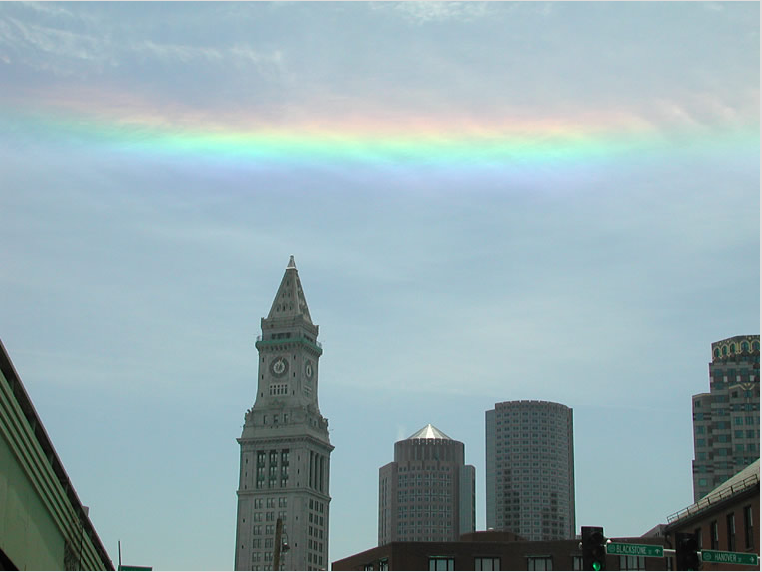Circumhorizon Arc
The Enchanting Phenomenon of the Circumhorizon Arc
Have you ever gazed up at the sky and witnessed a mesmerizing display of colors that seemed to defy the laws of nature? If so, you may have been lucky enough to witness a circumhorizon arc. This optical phenomenon is a rare and captivating sight that occurs in the Earth's atmosphere. In this article, we will delve deeper into the intricacies of the circumhorizon arc, exploring its formation, characteristics, and the conditions necessary for its occurrence.
What is a Circumhorizon Arc?
A circumhorizon arc, also known as a fire rainbow, is an optical phenomenon that manifests as a vibrant band of colors stretching across the sky. Unlike a traditional rainbow, which forms due to the refraction and reflection of sunlight through raindrops, the circumhorizon arc is caused by the refraction of light through ice crystals present in high-altitude cirrus clouds. This unique atmospheric phenomenon creates a breathtaking display of vivid hues that can span several degrees across the sky.
The Formation Process
To understand how a circumhorizon arc is formed, we must first delve into the science behind it. When sunlight passes through the hexagonal ice crystals in cirrus clouds, it undergoes a process known as refraction. This causes the light to bend and separate into its component colors, similar to what happens when light passes through a prism. The separated colors then emerge as a spectacular band of hues, creating the awe-inspiring spectacle we know as a circumhorizon arc.
Characteristics of a Circumhorizon Arc
A circumhorizon arc is characterized by its distinct shape and vibrant colors. It typically appears as a long, horizontal band of colors that arcs parallel to the horizon. The most common colors observed in a circumhorizon arc are red, orange, yellow, and green. However, under certain conditions, additional colors such as blue and violet may also be visible. This mesmerizing display of colors can span a considerable portion of the sky, often stretching from one end to the other.
The Optimal Conditions for Observing a Circumhorizon Arc
Witnessing a circumhorizon arc is an extraordinary event that requires specific atmospheric conditions to occur. Firstly, cirrus clouds, which are thin and wispy clouds found at high altitudes, must be present in the sky. These clouds consist of ice crystals that serve as the essential components for the formation of the arc. Additionally, the sun must be relatively high in the sky, at an elevation of around 58 degrees or more. This positioning is crucial to ensure that the sunlight passes through the ice crystals at the appropriate angle for refraction to occur.
Geographic Considerations
The occurrence of a circumhorizon arc is influenced by geographic factors such as latitude. The phenomenon is more commonly observed in regions closer to the equator, where the sun's elevation is higher throughout the year. In contrast, at higher latitudes, the sun's angle remains lower, making it less likely for the necessary conditions to align perfectly. Therefore, individuals residing in equatorial regions have a greater chance of witnessing this enchanting display in the sky.
Capturing the Beauty of a Circumhorizon Arc
Photographing a circumhorizon arc can be a challenging yet rewarding endeavor. Due to its expansive nature, capturing the entire arc within a single frame can be difficult. However, by using wide-angle lenses and positioning oneself at an elevated vantage point, photographers can capture the arc's grandeur against a stunning backdrop. The vibrant colors and ethereal beauty of the circumhorizon arc make it a sought-after subject for photographers and enthusiasts alike.
The Global Fascination with Atmospheric Phenomena
The circumhorizon arc is just one of many captivating atmospheric phenomena that have fascinated humans for centuries. From rainbows and halos to sunsets and auroras, these natural wonders have sparked wonder and curiosity throughout history. The study of atmospheric optics allows us to unravel the mysteries behind these mesmerizing displays, shedding light on the intricate workings of our atmosphere and the breathtaking beauty it can produce.
Conclusion
The circumhorizon arc is a captivating and rare atmospheric phenomenon that enchants those fortunate enough to witness it. Its formation through the refraction of sunlight through ice crystals in cirrus clouds creates a mesmerizing display of vibrant colors that span the sky. While specific conditions must align for a circumhorizon arc to occur, its occurrence serves as a reminder of the awe-inspiring wonders our atmosphere holds. So, next time you find yourself gazing up at the sky, keep your eyes peeled for this enchanting spectacle and prepare to be mesmerized by nature's artistic prowess.

Circumhorizon arc and Custom House Tower,
Boston Massachusetts.
The immensity of the circumhorizon arc is apparent against the city skyline.
Photographed by Gary Smiley in June 2000.
©Gary Smiley, used with permission.
Note: this article has been automatically converted from the old site and may not appear as intended. You can find the original article here.
Reference Atmospheric Optics
If you use any of the definitions, information, or data presented on Atmospheric Optics, please copy the link or reference below to properly credit us as the reference source. Thank you!
-
<a href="https://atoptics.co.uk/blog/circumhorizon-arc-5/">Circumhorizon Arc</a>
-
"Circumhorizon Arc". Atmospheric Optics. Accessed on April 24, 2024. https://atoptics.co.uk/blog/circumhorizon-arc-5/.
-
"Circumhorizon Arc". Atmospheric Optics, https://atoptics.co.uk/blog/circumhorizon-arc-5/. Accessed 24 April, 2024
-
Circumhorizon Arc. Atmospheric Optics. Retrieved from https://atoptics.co.uk/blog/circumhorizon-arc-5/.